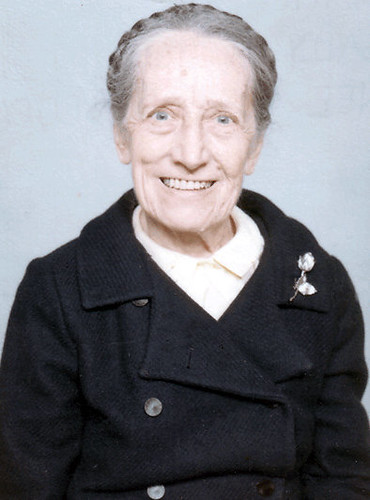My Direct Maternal Line

Pictured is my great-grandmother Eva Rice. Eva is my earliest known direct maternal ancestor. She was born around October 31, 1883 in Lithuania. Her name at birth was Ieva Daukšaitė, shortened to Eva Douse after immigrating to the United States. She took the surname Rice after marrying my great-grandfather Peter Rice, a descendant of the Lithuanian Račius family. Eva's father was Jonas Daukša. Her mother, whose name is not currently known, died in Lithuania, probably giving birth to Eva. For a full biography of Eva Rice, see my previous article on Familypedia.
Based on a sample of my mitochondrial DNA, Eva was of mt-DNA haplogroup T2. My closest mt-DNA match (perfect match to my HVR1 and HVR2) is with an individual from Bulgaria, whose earliest known maternal ancestor had the Slavic maiden name Fiyodorova. My next two closest matches (perfect match to my HVR1, but they did not test their HVR2) are with individuals whose earliest known maternal ancestors are of Polish origin, with maiden names Borek and Stefineski. The common maternal ancestor of all four lineages was likely a woman who lived in Poland or the Ukrane less than 2000 years ago. Although Lithuanians speak a Baltic language, it is not surprising that a person from Lithuania would have Slavic, and particularly Polish ancestry. Based on y-chromosomal DNA studies of Baltic populations, 38% of Lithuanians are of y-DNA haplogroup R1a, as are 55% of the population of Poland. (Another 42% of Lithuanians are of y-DNA haplogroup N, indicating relationship to Uralic speakers.)
Mt-DNA haplogroup T (ancestral to T2) likely arrived in Poland long before Indo-European y-DNA haplogroup R1a, as the incidence of haplogroup T corresponds more directly with R1 in Europe, generally, than it does with either of its R1a or earlier arriving R1b subclades individually (which, for reasons beyond the scope of this article, does not imply that mt-DNA haplogroup T and y-DNA haplogroup R1 are necessarily closely related).
The individual woman who first had the mutation that defined mt-DNA haplogroup T, my direct maternal ancestor, has been given the nickname "Tara" by geneticists. Tara probably lived in the Near East, more than 45,000 years ago. Tara was also a direct maternal ancestor of outlaw Jesse James, and Tsar Nicholas II. The International Society of Genetic Genealogy places haplogroup T2 (shared by Jesse James, Tsar Nicholas II and myself) in Europe sometime between the late Stone Age and 8000 BC.
My Father's Direct Maternal Line

This is a photograph of my great-grandmother Maria Freudenberg (1895-1987), the common direct maternal ancestor of my father and my cousin Richard Norton who shared his mt-DNA results with me. Maria was born Maria Elizabeth Winblad. Maria's mother was Salmine Sofie Severine Olsdatter (1862-1914), who was born in Farsund, Vest-Agder, Norway. Salmine's mother was Thea Johanne Tostensdatter (1825-1865), born in Kristiansand, Vest-Agder, Norway. Thea's mother was Johanne Jacobsdatter (1795-?), born in Eigersund, Rogaland, Norway. Johanne's mother was Gitlaug Tollaksdatter (1773-1806), born in Hå, Rogaland, Norway. Gitlaug's mother was Ingeborg Pedersdatter (c1747-?), believed to have been born in Eigersund.
Based on a sample of my cousin's mitochondrial DNA, Ingeborg Pedersdatter was of mt-DNA haplogroup W. Her closest mt-DNA match (perfect match to Richard's HVR1 and HVR2) is with an individual whose earliest known maternal ancestor was a woman named Karen Knudsdatter. Karen was married January 13, 1734 in Nord-Aurdal, Oppland, Sweden, to Enblebret Tostensen. Statistically speaking, Ingeborg Pedersdatter and Karen Knudsdatter are likely to share a common direct maternal ancestor, perhaps 60 generations back, somewhere in Europe. However, the close proximity between Eigersund and Nord-Aurdal (approximately 300 miles as the crow flies) suggests that the most recent common mt-DNA mutation probably occurred much closer to the present, and specifically in a woman who resided in Norway.
1 comment:
Tara originated in Tuscany.
Post a Comment